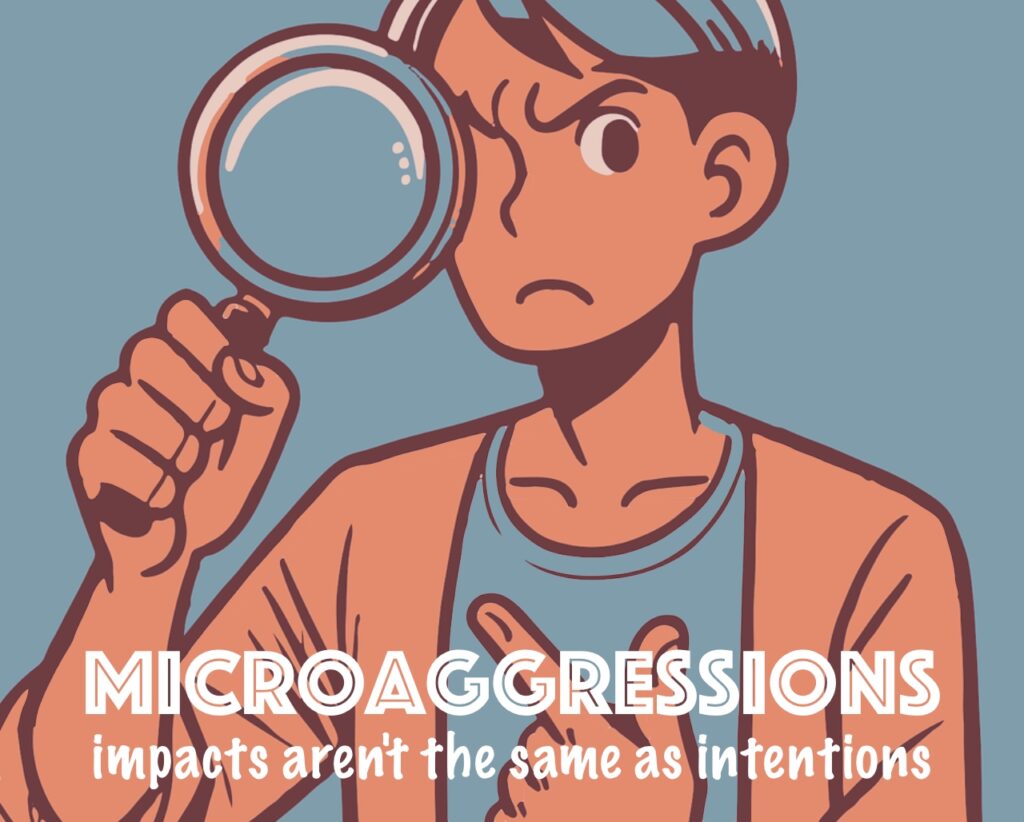Microaggressions – non-overt, discriminatory interpersonal exchanges where one person sends a negative and harmful message to another person due to their belonging in a certain social or cultural group
Microaggressions, a subtle but offensive comment or action directed at a minority or other non dominant group that often unintentionally or unconsciously reinforces a stereotype: microaggressions such as “I don’t see you as black.”

Defined by Derald Sue as “brief and commonplace daily verbal, behavioral, or environmental indignities, whether intentional or unintentional, that communicate hostile, derogatory, or negative racial slights and insults toward people of color,” microaggressions exist everywhere, reinforcing deep rooted ideologies of power and privilege in subtle, daily ways.
The discussion of, and subsequent push to highlight and recognize, microaggressions in our everyday lives invites us to confront the idea that “I am not racist” when in fact we should all likely perpetuate microaggressions. They can be subtle, but they are certainly cumulative when they are encountered in all aspects of daily life: in school, in the media, even at your local grocery store. Assumptions creep into everyday speech and your ear becomes sharpened to them.
||| Explore the Literature |||
Domínguez, Silvia and Embrick, David G. 2020. Racial microaggressions: Bridging psychology and sociology and future research considerations. Sociology Campus. 14:e12803.
Abstract: This article reviews racial microaggressions, specifically psychology and sociology’s historical trajectory in informing existing literatures and disciplines, in its connections to meso and macro levels of systemic racism. In doing so, we contend that a sociological understanding of racial microaggressions presents opportunities to better understand the cumulative and deleterious effects of racial violence on racialized groups. Furthermore, we argue that beyond bridging the disciplines of psychology and sociology to allow for more interdisciplinary analyses of racial microaggressions will help to move conversations in ways that more meaningfully capture the monstrosity of white supremacy and its cumulative deleterious effects of daily racial terrorism at all levels of society.
Hall, Joanne M, and Becky Fields. 2015. “”It’s Killing Us!” Narratives of Black Adults About Microaggression Experiences and Related Health Stress.” Global qualitative nursing research vol. 2.
Abstract. Perceived racism contributes to persistent health stress leading to health disparities. African American/Black persons (BPs) believe subtle, rather than overt, interpersonal racism is increasing. Sue and colleagues describe interpersonal racism as racial microaggressions: “routine” marginalizing indignities by White persons (WPs) toward BPs that contribute to health stress. In this narrative, exploratory study, Black adults (n = 10) were asked about specific racial microaggressions; they all experienced multiple types. Categorical and narrative analysis captured interpretations, strategies, and health stress attributions. Six iconic narratives contextualized health stress responses. Diverse mental and physical symptoms were attributed to racial microaggressions. Few strategies in response had positive outcomes. Future research includes development of coping strategies for BPs in these interactions, exploration of WPs awareness of their behaviors, and preventing racial microaggressions in health encounters that exacerbate health disparities.
Holling, Michelle A. 2019. “You Intimidate Me” as a Microaggressive Controlling Image to Discipline Womyn of Color Faculty. Southern Communication Journal 84:2, 99-112.
Abstract: This study used critical ethnography to document microaggressions experienced by women Staff and Faculty of Color at a predominantly White institution of higher education. This article focuses on invisibility, a specific type of microaggression, which emerged as a prominent finding. Participant narratives explicated three manifestations of environmental microaggressions (campus, disciplinary/professional, and community invisibility) and two forms of interpersonal microaggressions (professional and leadership invisibility). Recommendations for higher education professionals are provided.
Hill, Jane H. 1998. Language, Race, and White Public Space. American Anthropologist, 100: 680-689.
Abstract: White public space is constructed through (1) intense monitoring of the speech of racialized populations such as Chicanos and Latinos and African Americans for signs of linguistic disorder and (2) the invisibility of almost identical signs in the speech of Whites, where language mixing, required for the expression of a highly valued type of colloquial persona, takes several forms. One such form, Mock Spanish, exhibits a complex semiotics. By direct indexicality, Mock Spanish presents speakers as possessing desirable personal qualities. By indirect indexicality, it reproduces highly negative racializing stereotypes of Chicanos and Latinos. In addition, it indirectly indexes “whiteness” as an unmarked normative order. Mock Spanish is compared to White “crossover” uses of African American English. Finally, the question of the potential for such usages to be reshaped to subvert the order of racial practices in discourse is briefly explored.
Williams, Monnica T. 2020 “Microaggressions: Clarification, Evidence, and Impact.” Perspectives on Psychological Science 15, no. 1: 3–26.
Abstract: [T]he current article provides a response that systematically analyzes the arguments and representations made in Lilienfeld’s critique with regard to the concept of microaggressions and the state of the related research. I show that, in contrast to the claim that the concept of microaggressions is vague and inconsistent, the term is well defined and can be decisively linked to individual prejudice in offenders and mental-health outcomes in targets. I explain how the concept of microaggressions is connected to pathological stereotypes, power structures, structural racism, and multiple forms of racial prejudice. Also described are recent research advances that address some of Lilienfeld’s original critiques. Further, this article highlights potentially problematic attitudes, assumptions, and approaches embedded in Lilienfeld’s analysis that are common to the field of psychology as a whole. It is important for all academics to acknowledge and question their own biases and perspectives when conducting scientific research.